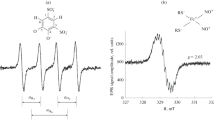Abstract
This paper briefly presents a critical review concerning the chemical reactions involved when superoxide or hydrogen peroxide meet iron complexes. The data commented on are required for a correct interpretation of the chemical processes which play a paramount role in the biological activation of dioxygen and arise in normal metabolism as well as in pathological processes.
Similar content being viewed by others
References
Ahmad S, Mc Callum JD, Shiemke AK et al. 1988 Raman spectroscopic evidence for side-on binding of peroxide ion to Fe(III)-EDTA. Inorg Chem 27, 2230-2233.
Brennan BA, Chen Q, Juarez-Garcia C et al. 1991 Models for diiron-oxo proteins: the peroxide adduct of Fe2(HPTB)(OH)(NO3)4. Inorg Chem 30, 1937-1943.
Borg DC, Schaich KM. 1986 Prooxidant action of desferrioxamine: Fenton like production of hydroxyl radicals by reduced ferrioxamine. J Free Rad Biol Med 2, 237-243.
Coves J, Fontecave M. 1993 Reduction and mobilization of iron by a NAD(P)H:flavinoxidoreductase from Escherichia coli. Eur J Biochem 211, 635-641.
Crichton RR. 1991 Inorganic Biochemistry of Iron Metabolism. New-York, London: Ellis Horwood.
Fontecave M, Menage S, Duboc-Toia C. 1998 Functional models of non-heme iron enzymes. Coord Chem Rev 178–180, 1555-1572.
Gutteridge JMC, Maidt L, Poyer L. 1990 Superoxide dismutase and Fenton chemistry; reaction of ferric-EDTA complex and ferric bipyridyl complex with hydrogen peroxide without the apparent formation of iron(II). Biochem J 269, 169-174.
Kraiter DC, Zak O, Aisen P, et al. 1998 A determination of the reduction potentials for diferric and C-and N-lobe monoferric tansferrins at endosomal pH(5.8). Inorg Chem 37, 964.
Luzzatto E, Cohen H, Stockheim C, et al. 1995 Reactions of low valent transition metal complexes with hydrogen peroxide. Are they Fenton-like or not? The case of Fe (II)L, L = EDTA, HEDTA and TCMA. Free Rad Res 23, 453-463.
Meunier B. 1992 Metalloporphyrins as versatile catalysts for oxidation reactions and oxidative DNA cleavage. Chem Rev 92, 1411-1456.
Nivière V, Fontecave M. 1995 Biological source of reduced oxygen species. In: Favier AE, Cadet J, Kalyanaraman B et al. eds. Analysis of Free Radicals in Biological Systems. Basel, Boston, Berlin: Birkhäuser; 11-19.
Pierre JL. 1995 Chemistry of dioxygen and its activated species. In: Favier AE, Cadet J, Kalyanaraman B, et al. eds. Analysis of Free Radicals in Biological Systems. Basel, Boston, Berlin: Birkhäuser; 1-10.
Yamazaki I, Piette LH. 1990 ESR spin-trapping studies on the reaction of Fe2+ions with H2O2-reactive species in oxygen toxicity in biology. J Biol Chem 265, 13589-13594.
Yamazaki I, Piette LH. 1991 ESR spin-trapping studies on the oxidizing species formed in the reaction of the ferrous ion with hydrogen peroxide. J Am Chem Soc 113, 7588-7593.
Author information
Authors and Affiliations
Rights and permissions
About this article
Cite this article
Pierre, J., Fontecave, M. Iron and activated oxygen species in biology: The basic chemistry. Biometals 12, 195–199 (1999). https://doi.org/10.1023/A:1009252919854
Issue Date:
DOI: https://doi.org/10.1023/A:1009252919854




